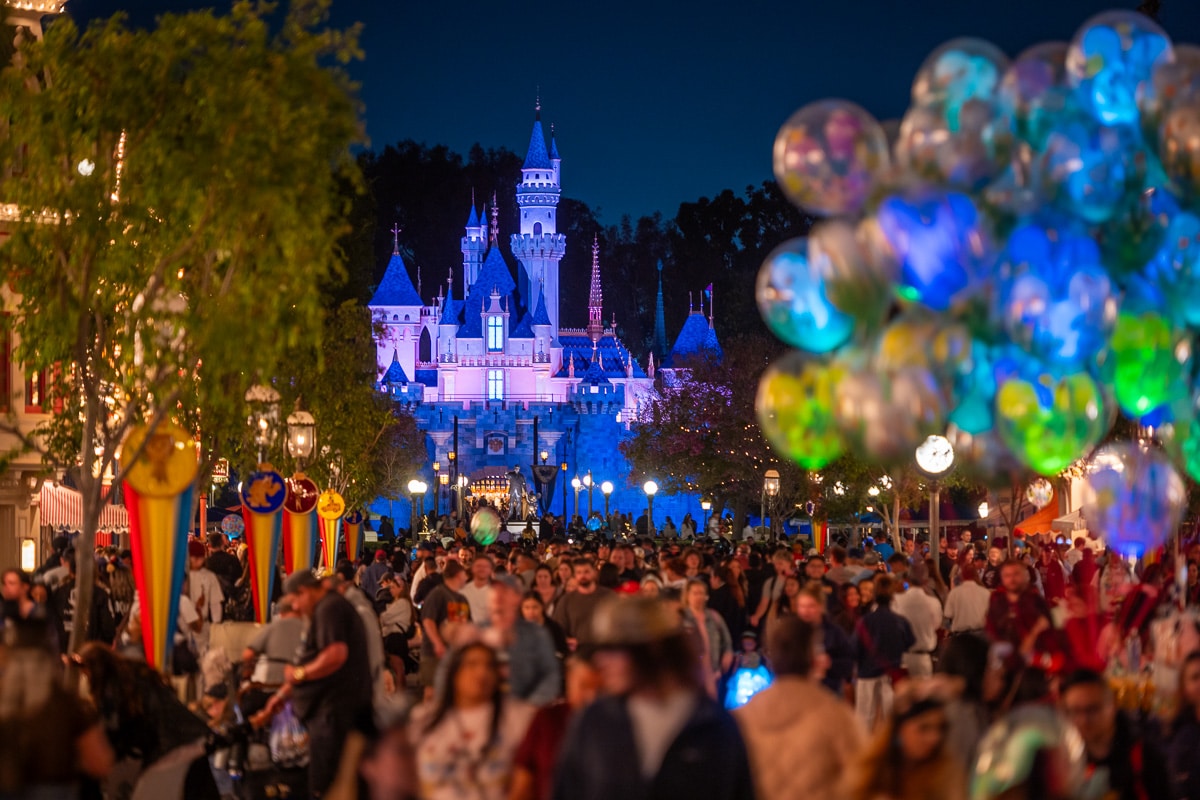

The Walt Disney Company held its 2025 Annual Meeting of Shareholders on Thursday, and CEO Bob Iger highlighted a year of successes at the box office, via the streaming services, and at the theme parks–while also looking forward at the billions of dollars of planned investments in the coming years.
During the Q&A portion of the meeting, Iger fielded an investor’s question expressing concern about the impact of price increases on affordability and attendance, and the need to further increase capacity to prevent losing fans in the long term. This line of questioning was expected, as Walt Disney World is Worried About Its High Prices has been an ongoing topic since bombshell reporting by the Wall Street Journal last month.
That report revealed concerns about Disney pricing out the middle class, not just among fans, but that alarms are also being sounded inside the company, as executives fear price increases are alienating fans and souring sentiment. According to WSJ, “some inside Disney worry that the company has become addicted to price hikes and has reached the limits of what middle-class Americans can afford.”
Responding to a question that Disney’s domestic theme parks have not been able to keep up with rising attendance, need more capacity, and that this has created affordability issues, Iger acknowledged that this is something he thinks about all the time. “In fact, I was just at Walt Disney World on a weekday in March, and the place was really busy, really across the whole property,” Iger said. We mentioned encountering heavy crowds in Pandora – World of Avatar, Star Wars: Galaxy’s Edge, Guardians of the Galaxy: Cosmic Rewind, TRON Lightcycle Run, Toy Story Land, and even at Disney Springs.
Iger indicated that “consumer demand for our parks and resorts remains extremely high, as is the value we offer, which is tremendous when you compare it with other forms of entertainment such as sporting events and concerts.” He pointed out that the additions made to Disney Parks worldwide, like those he referenced, provide more capacity and more value to guests.
Iger further stressed that these expansion efforts are ongoing. “In fact, we have more being designed, developed, and built today than at any other point in the 70 years since we’ve been in the theme park business.” At the same time, he said the company also appreciates that the parks create lifelong memories for families.

With that in mind, Disney is constantly considering, developing, and implementing new ways to make the theme parks more enjoyable, but equally important, more accessible to guests on tighter budgets.
“We provide several options for families looking to spend less, including our lowest price ticket to Disneyland, which we’ve kept at the same level since before the COVID pandemic,” Iger added. He added that since his return as CEO two years ago, Disney tripled the number of days that this lowest priced ticket is available.
“So with strong guest satisfaction scores and intent to visit metrics remaining very high, our parks remain the most popular offering in the industry and a solid growth business for the company, as we continue to introduce new experiences that I just referenced,” Iger concluded.

Our Commentary
Most of what Bob Iger had to say is wholly unsurprising, and perfectly “on script” with Disney’s Response to Rising Costs Criticism. As you might recall, the Walt Disney Company put out a press release on its corporate website the day after the WSJ report that offered an indirect response explaining how the Disney’s theme parks offer great value for money, affordable options for families, and most guests believe that Disney park visits create memories that last a lifetime and can’t be replaced or replicated.
As with the question about Figment, the company likely anticipated this question or one like it, and Iger was prepped on how to respond. That press release likely served as the blueprint for his response given the tremendous amount of overlap. In other words, not much new “new” to report here.
Nevertheless, there are a couple things I thought were briefly worth addressing.

The first is Iger’s comment that he was just at Walt Disney World last week and, even on a weekday in March, it was really busy.
Late last week would’ve been the start of spring break season for Central Florida (and beyond) school districts. Even prior to that, it was early spring break for plenty of other schools, including many colleges. Sure, it’s not the heart of spring break season, but it’s also not as if those dates were random weekdays during the off-season when all schools are in-session.
Moreover, the first few months of the year have been outperforming even in the post-pent-up demand period, which is presumably in part due to travelers with flexibility shifting visits to these more comfortable times of year. I’d be curious to hear Iger’s unfiltered thoughts if he were to visit Animal Kingdom on May 22 or August 19. Something tells me he wouldn’t feel quite as confident, even if he wouldn’t say as much publicly.

Second, this was a multifaceted question (a rare really good one from the Q&A!) about the intersection of capacity and affordability.
In response, Iger pointed to several completed projects. I will happily concede that every single one of these was a major addition that expanded capacity. Even the ones that replaced existing areas, as no one can argue with a straight face that the utilization of Camp Minnie-Mickey was the same as Pandora. Ditto Universe of Energy and Cosmic Rewind–and I say that as a fan of the former!
I’m not sure if the same can be said for all of the upcoming projects. All will definitely improve utilization, but with the exception of the Magic Kingdom projects, not nearly to the same extent as the last round of expansion. Animal Kingdom desperately needs Tropical Americas and it’s a great start, but that’s all it is–a start. The addition of Monstropolis at DHS is, on balance, a net of one new ride.
The bigger issue here is the purposeful throttling of capacity. Look no further than Disneyland, where crowds are currently crazy (more on that in a bit), but has multiple theaters sitting empty, a shortage of nighttime entertainment, no daytime parade, etc. There are examples like this with almost all of the parks (the #1 issue at Walt Disney World would be shorter hours at Magic Kingdom), and there are ample opportunities for the overnight introduction of crowd-absorbing capacity. In other words, the crowds and pricing are a choice that they’ve elected to make, not something unavoidable.

Turning to pricing, Iger once again points to the lowest-price 1-day tickets at Disneyland, which haven’t gone up in price for several years. It’s been since at least 2018, pre-COVID and pre-Star Wars: Galaxy’s Edge. Disneyland has shifted things around and moved the $104 tickets to a new “Tier 0” a few years ago, but the starting price has not gone up.
It’s also true that, a couple of months after Iger returned, one of the major moves made by Disneyland was to expand the calendar to offer nearly two months’ worth of $104 park ticket dates. At present, there are only 20 such dates on the calendar for this year through September 2025, but it’s likely more will be added in November and December. Still, nowhere near two months’ worth in total.
The company loves to tout this. It always comes up as a talking point about their commitment to affordability, and makes its way into statements from the company to media outlets in otherwise negative pieces (like the WSJ one) as a counterpoint. To their credit, it’s an effective argument.

Honestly, I was really surprised when 2025 Walt Disney World tickets were released and the starting price for single day tickets increased for the first time since October 2018. From then until last September, single day prices started at $109, which had been the base price since the introduction of the date-based system back in October 2018. Starting this fall, those have now gone up to $119.
As with the Disneyland’s $104 starting price, this made for a great talking point. But if you paid attention, it also made for an amusing one. What Walt Disney World always declined to mention was that the $109 minimum was only for a scattering of dates during the off-season at Animal Kingdom, when the already hot park is surface-of-sun levels of scorching. Never mentioned was that 1-day ticket prices have continued to skyrocket at Magic Kingdom, the park for which most guests are actually purchasing single-day tickets.
I still wonder what led to that change at Animal Kingdom. It’s not like DAK is selling 1-day tickets during the off-season like hotcakes. It’s also not like 2025 is going to be a strong year for Animal Kingdom, what with the construction walls and closed rides and all. Was it really worth it to give up the talking point and perception of cheaper tickets? Or was this price increase done without consulting the corporate communications folks, who might’ve stopped the idea, wanting to maintain the narrative of “no base ticket price increases for 7+ years running”? I can’t imagine much money was being left on the table with $109 vs. $119 tickets to Animal Kingdom.

On the other hand, money is absolutely being left on the table with the $104 tickets at Disneyland.
This is hopefully going to come as no surprise, but Disneyland is a much stronger park than Animal Kingdom. I don’t think even the most zealous “Nahtazu” proponents can argue that, objectively speaking, Disneyland holds more appeal. I mean, c’mon, it has like quintuple the number of rides.
It’s just interesting to see this tactic maintained at Disneyland, where it really doesn’t need to be, and abandoned at Animal Kingdom, where it probably should’ve been kept. And if you need “proof” that Disneyland is leaving money on the table, just look at crowds in August and September on days when those $104 tickets make their return. There has been a growing trend for Disneyland to see significant spikes when tickets are cheaper, and a drop when they’re more expensive. This was evidenced last August and September (cheaper months) versus October (the most expensive month, on average).

It’s also evident right now. As we pointed out in the latest update to our 2025 Disneyland Crowd Calendar, the last 6 consecutive days have been 9/10 or 10/10 crowd levels, as have 10 out of the last 13 days.
This is busier than we anticipated, and on some dates, significantly so. You might say this is unsurprising given that it’s the start of spring break season, and–sure–crowds were expected to be elevated as a result. But not 9/10 or 10/10 crowd levels.
Spring break is only part of the equation–and arguably the smaller component. More relevant is the ongoing and aggressive Southern California Resident Ticket Deal as well as the end of the Kids’ Ticket Deal. As a result, the last week has been busier than the peak week between Christmas and New Year’s Eve!

Bringing things full circle, this illustrates a couple of points. The first is that Bob Iger’s comments about crowds would’ve been more apt if applied to Disneyland (but as illustrated above, even that is “solvable” with more entertainment). With few exceptions, it is busy most of the time in the California parks–far worse than Walt Disney World.
The second is that the biggest driver of attendance for Disneyland is lower prices. Whether it be ticket deals or Tier 0/1/2 prices, crowds often exceed expectations when pricing is lower and fall short when peak pricing is in place and more Annual Passes are blocked out.
You might even suggest that–despite the nearly-perpetual heavy crowds–Disneyland actually has a bit of a pricing problem because it’s so reliant on deals to achieve its attendance. When there aren’t discounts or lower prices, crowds underperform. With that said, “a bit of a problem” is pretty far from a five-alarm fire. Disneyland is doing just fine, and will be for the foreseeable future thanks to the 70th.
Anyone who has set foot in Disneyland over the last year-plus could tell you that the company has nothing to be worried about there, and contentions that it’s on the precipice of a major slowdown are wishful thinking at best. On the other hand, Walt Disney World might be a different story thanks to the exhaustion of pent-up demand, slowdown in tourism and international travel, and Epic Universe offering increased competition just down the road.
Planning a Walt Disney World trip? Learn about hotels on our Walt Disney World Hotels Reviews page. For where to eat, read our Walt Disney World Restaurant Reviews. To save money on tickets or determine which type to buy, read our Tips for Saving Money on Walt Disney World Tickets post. Our What to Pack for Disney Trips post takes a unique look at clever items to take. For what to do and when to do it, our Walt Disney World Ride Guides will help. For comprehensive advice, the best place to start is our Walt Disney World Trip Planning Guide for everything you need to know!
YOUR THOUGHTS
What do you think of Disney CEO Bob Iger’s response to the concerns of price increases and a lack of capacity increases creating long-term affordability issues and return visits? What would you like to see done to improve the dynamic at Walt Disney World or Disneyland? Think that runaway price increases are the big concern, or is the value proposition an equally or more significant matter? Do you agree or disagree with our assessment? Any questions we can help you answer? Hearing your feedback–even when you disagree with us–is both interesting to us and helpful to other readers, so please share your thoughts below in the comments!












